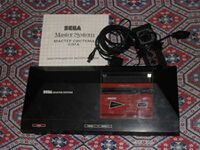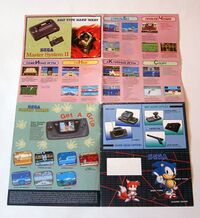History of Sega in Russia
From Sega Retro

|
| History of Sega in Russia |
|---|
| Official Sega distributor(s): Forrus(1994-1996),Bitman(1996-1997),R-Style(1997-200x),1C-SoftClub(200x-present) |
This short article is in need of work. You can help Sega Retro by adding to it.
Sega has had a presence in Russia for a good many years, however detailed information is in short supply. This page sums up what we know.
Contents
Sega Master System
Whilst still a part of the Soviet Union a version of the Sega Master System (model no. MK-3096-19) was made for the Russian market in 1990. This featured a SECAM board in order to be compatible with the Soviet TV standard. It was unusual for a model one in lacking a card slot and a reset button, much like the Master System II which would also be released in 1990 in the US and some other countries.
Forrus
As a soviet state up until the early 1990s, Russia's video game history is almost nonexistent. Video gaming only really kicked off in 1992, when a Russian importing company, Steepler created the "Dendy", an own-branded Famicom sourced from Chinese manufacturers. Copyright laws are hazy and the Dendy does not seem to have been challenged by Nintendo (they certainly failed to halt production - they might even have given permission to Steepler).
Sega's initial attempt to enter the Russian market appears to have had very little success. However, Sega re-entered the market around August 1994, through Nissho Iwai, a Japanese firm which had operated in Russia for decades, who in turn picked a distributor, Forrus, to distribute Sega consoles and games in the country. Sega would sell stock to Nissho Iwai, who would sell it to Forrus, who would distribute to retailers across the country.
The Sega Mega Drive (model 2), Sega Master System (model 2), Sega Mega-CD (model 2) ,Sega Game Gear and Sega Multi Mega were sold in Russia, with the same selection of PAL games seen in Europe (at least, in regards to first-party releases),however despite widespread publicity and even the commissioning of a weekly television show promoting Sega products, the endeavour appears not to have been a particular success, with the distribution rights getting given to a new company within two years.
At first the Mega Drive played second best to the Dendy, though would gradually rise in popularity over time. However, little of the Mega Drive's success in Russia lies with Sega - within months of release, unlicensed clone consoles flooded the market and were able to significantly undercut Sega - an extremely important factor in the early days of post-Soviet Russia, where in 1993 it is estimated that 39-49% of the population was classed as being in poverty.
Also Steepler, who was known for selling the Dendy console, began selling the Sega products in Russia and the CIS countries in 1994. However, these were American and Asian versions of Sega Mega Drive model II and Sega Genesis CDX with games also from this regions. Along with appeared of games and consoles from two different regions, the company added Sega Mega Key which broke the regional blockade. Help in selling was also from the "Dendy" company which was chain of stores created in 1994 who sold Steepler products . After the company became Nintendo in late 1994, the sale and promotion of Sega products by the company was limited.
Competitors to the Mega Drive included the Super Bitman, Mega-Ken, Pro 16 Bit and SB-16C, all of which originate from China or Taiwan. It is a similar story for games and accessories - as what was seen on-screen rarely differed from the official products, it was nearly impossible for Sega to gain ground. This feature of the Russian market still exists to this day, with cheaply made Mega Drive clones and games (including Russian translations and entirely original releases) continuing to be sold well after official support for the console was dropped (although some systems are manufactured in Russia now too).
Bitman
At a joint press conference on June 6th, 1996 Sega Europe and Bitman announced that Bitman was the new Sega distributor for Russia and the CIS (former USSR) countries. Bitman was a former clone maker who also owned a chain of stores. Bitman distributed the Sega Mega Drive II, Sega Saturn, Sega Pico ,Sega Nomad and Super Bitman in Russia and CIS.
R-Style
In 1997, Bitman was acquired by R-Style. All stores have become the property of this company. R-Style continued selling Sega products.
- Sega Russia.jpg
Advertisement from 1998
Sega Dreamcast
The Sega Dreamcast also made it to the country, although probably not officially. The hardware came with a translated Russian manual. The late 2002 - 2003 dates seen on documents suggests that these were excess European stock from after Sega sold off their European stocks to Bigben Interactive in April 2001. Games were distributed with custom-made packaging, again potentially without a license.There were a few companies that translated and sold games:
- Vector (Вектор)
- Kudos
- RGR Studio
- Paradox (Do not be confused with another company that produce games)
- Playzero
- Pinachet Game
1C-SoftClub
Somewhere at the beginning of the 20th century, SoftClub became a distributor of Sega in Russia and CIS, which became a part of the company 1C.
Mega Drive Portable
During the mid-2000s when the technology became inexpensive, a new Mega Drive "standard" was adopted by a set of unknown Russian companies under the banner of Mega Drive Portable. Games were placed in custom-made Game Boy Advance-style cartridges and are compatible in a number of different devices, most of whom steal design tips from Nintendo consoles. Once again the legality is questioned.
NewGame Consoles
A company known as NewGame also took it upon themselves to translate Mega Drive games into Russian and produce their own set of consoles - the Magistr Drive.
- Magistr Drive Russia.jpg
Advertisement about Magistr Drive in 2000
- New Game Russia 2.jpg
- New Game Russia 3.jpg
- New Game Russia 1.jpg
Homebrew Games
There appears to be a strong homebrew Mega Drive community in Russia, with many of their creations leaking into the commercial market by dodgy eBay sellers.
AtGames Presence
The only guaranteed official source of Sega games and hardware in Russia throughout its entire history are products created by AtGames, which have a worldwide license to produce Sega consoles. A good chunk of their consoles have been released in the region, including the Arcade Classic and the Arcade Ultimate. Blue and green versions of the Arcade Ultimate appeared in Russia before other regions of the world (namely the UK, in which Blaze Europe introduced the blue variant in 2011), suggesting strong support from AtGames in that region.
The Micro Drive is currently exclusive to Russia.
Modern Titles
More modern games for the PlayStation 2 and beyond seem to be distributed in Russia legally without much concern. The country seems to have adopted the PEGI rating system and games are translated into Russian in a similar manner to other European regions.
Commercials
References


